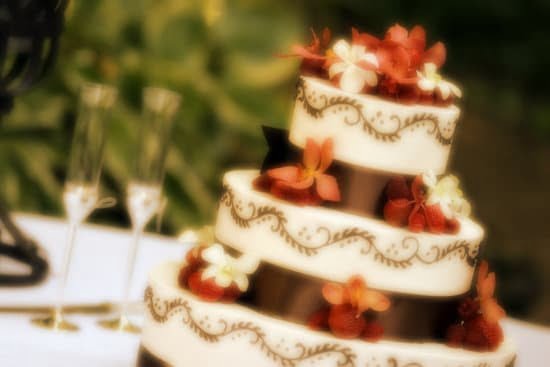Are you looking to add a beautiful and elegant touch to your cakes? Learn how to decorate cake with rosettes and elevate your baking game to the next level.
Rosette cake decorating is a popular and visually stunning technique that can take your cakes from plain to eye-catching in just a few simple steps. Whether you’re a beginner or a seasoned baker, mastering the art of creating perfect rosettes will bring your cakes to life and impress any dessert lover.
To get started with rosette cake decorating, you’ll need the right tools and materials. From piping bags to different frosting tips, there are essential items that will make the process much easier and more enjoyable. In addition, choosing the right type of frosting is crucial for creating beautiful and long-lasting rosettes. With the right guidance, you’ll be able to create stunning rosettes that will leave everyone amazed at your baking skills.
This article will guide you through everything you need to know about rosette cake decorating, including step-by-step instructions on creating perfect rosettes, tips for achieving consistent and beautiful designs, adding color to your rosettes, alternative techniques for a unique look, troubleshooting common issues, as well as displaying and serving your finished masterpiece. So, let’s jump right in and unlock the secrets of mastering the art of rosette cake decorating.
Essential Tools and Materials for Rosette Cake Decorating
Rosette Cake Decorating requires a few essential tools and materials to achieve beautiful and professional-looking results. In order to create perfect rosettes, you will need to have the right equipment at your disposal. Here are the must-have items for rosette cake decorating:
- Piping Bags: These are essential for creating rosettes as they allow you to control the flow of frosting and create the desired shape.
- Piping Tips: You will need a large closed star piping tip to create the classic rosette shape. Make sure it is high-quality and durable for best results.
- Turntable: A turntable is crucial for smooth and consistent piping. It allows you to rotate the cake while piping, making it easier to create uniform rosettes around the entire cake.
- Offset Spatula: An offset spatula is necessary for applying a crumb coat and final frosting layer before piping the rosettes.
- Frosting: When it comes to frosting for rosette cake decorating, it’s important to use a stiff consistency buttercream or cream cheese frosting. This will help your rosettes hold their shape and not droop or melt off the cake.
| Essential Tools | Materials |
|---|---|
| Piping Bags | Frosting |
| Piping Tips | Cake Turntable |
| Turntable | Offset Spatula |
Mastering these techniques provides an ideal foundation for creating stunning cakes that can be used in various celebrations. Whether you’re decorating a birthday cake, wedding cake, or any other special occasion dessert, learning how to decorate a cake with rosettes can elevate your baking skills and impress your friends and family with beautiful and delicious creations.
Choosing the Right Frosting for Rosettes
When it comes to creating beautiful rosettes on a cake, choosing the right frosting is key. The consistency and texture of the frosting will have a significant impact on how well your rosettes hold their shape, as well as the overall look of the finished product.
Buttercream Frosting
One of the most popular choices for creating rosettes is buttercream frosting. Its creamy texture and smooth finish make it ideal for piping intricate designs like rosettes. To achieve the best results with buttercream, it’s important to ensure that the frosting is at the right consistency. If it’s too stiff, it will be difficult to pipe smooth and uniform rosettes. On the other hand, if it’s too soft, the rosettes may not hold their shape.
Royal Icing
For those looking for a more traditional and firm option, royal icing is another great choice for creating rosettes. This type of icing dries hard and holds its shape well, making it perfect for intricate designs that need to stand out on a cake. Royal icing can also be tinted with food coloring to achieve vibrant and colorful rosettes.
Cream Cheese Frosting
If you prefer a lighter and tangier option, cream cheese frosting can also be used for creating rosettes. With its slightly softer texture compared to buttercream, cream cheese frosting can result in more delicate and soft-looking rosettes that are perfect for certain cake designs.
Step-by-Step Guide on Creating Perfect Rosettes
Creating perfect rosettes on a cake may seem like a daunting task, but with the right technique and practice, anyone can achieve beautiful results. Follow these step-by-step instructions to learn how to decorate a cake with rosettes like a pro.
Gather Your Materials
Before you start piping rosettes onto your cake, make sure you have the essential tools and materials on hand. You will need a piping bag fitted with a large star tip, an offset spatula for smoothing the frosting on the cake, and of course, your choice of frosting. It’s important to use a sturdy piping bag that won’t burst under pressure, and a large star tip will create the classic rosette shape.
Prepare Your Cake
Begin by preparing your cake for decorating. Make sure it is completely cooled before applying any frosting. Use the offset spatula to create a thin layer of frosting, known as a crumb coat, over the entire surface of the cake. This will help seal in any loose crumbs and provide a smooth base for piping the rosettes.
Piping Perfect Rosettes
To pipe perfect rosettes onto your cake, hold the piping bag at a 90-degree angle to the surface of the cake. Starting from the outer edge, apply even pressure to the piping bag while using a circular motion to create a spiral shape. Continue piping towards the center of each rosette until you achieve your desired size. Practice on parchment paper before piping directly onto your cake to get comfortable with the motion.
By following these steps and practicing consistently, you’ll soon be able to confidently decorate cakes with stunning and professional-looking rosettes. Remember that mastering this art takes time and patience, so don’t be discouraged if your first attempts aren’t perfect – keep practicing and experimenting with different techniques to find what works best for you.
Tips and Tricks for Achieving Consistent and Beautiful Rosettes
Creating beautiful and consistent rosettes on a cake can seem daunting, but with the right technique and practice, you can achieve stunning results. Here are some tips and tricks to help you master the art of decorating cakes with rosettes.
First, it’s important to ensure that you have the right consistency of frosting for your rosettes. The frosting should be stiff enough to hold its shape, but not so stiff that it’s difficult to pipe. If the frosting is too soft, the rosettes may lose their definition, while frosting that is too stiff can make piping difficult. Finding the perfect consistency may take some trial and error, but it’s essential for creating beautiful rosettes.
Another key factor in achieving consistent and beautiful rosettes is practicing your piping technique. Before decorating your actual cake, take some time to practice piping rosettes on a flat surface or a practice board. This will help you get a feel for how the frosting behaves as you pipe and allow you to make any necessary adjustments before working on your cake.
Finally, when piping rosettes on your cake, be sure to maintain a steady hand and consistent pressure as you pipe. Uneven pressure or movement can result in uneven or misshapen rosettes. Take your time and focus on creating each rosette slowly and deliberately for the best results.
| Tips for Consistent Rosettes | Method |
|---|---|
| Use frosting with the right consistency | Adjust stiffness for best results |
| Practice piping technique | Improve skills before decorating cake |
| Maintain steady hand and pressure | Create even and beautiful rosettes |
Adding Color to Your Rosettes
Once you’ve mastered the art of creating perfect rosettes on your cake, the next step is to add some color to make them pop. There are several ways to achieve this, depending on your desired look and the tools you have at your disposal.
One simple way to add color to your rosettes is to use a piping bag fitted with a multi-color tip. These tips typically have two or more smaller openings that allow you to pipe two or more colors at once, creating a beautiful multicolored effect on each rosette. Alternatively, if you don’t have a multi-color tip, you can simply paint different colors of food coloring inside the piping bag before filling it with frosting.
Another popular method for adding color to rosettes is by using edible dusts or edible glitter. Once your rosettes are piped onto the cake, lightly dust them with the edible powder or sprinkle them with glitter for a shimmering and eye-catching finish.
If you’re feeling particularly artistic, consider using food coloring and a small paintbrush to hand-paint each individual rosette. This allows for complete customization and gives you the freedom to create any design or pattern you desire.
With these various methods for adding color to your rosettes, the possibilities are endless when it comes to creating a stunning and visually appealing cake that is sure to impress any crowd. Mastering how to decorate cake with rosettes opens up a world of creativity and adds that extra special touch to any celebration.
Alternative Rosette Techniques for a Unique Look
One alternative technique for creating unique rosette designs on a cake is the two-tone rosette method. This involves using two different colors of frosting to create a two-toned effect in each rosette. To achieve this look, fill one side of a piping bag with one color of frosting and the other side with another color.
When piping the rosettes onto the cake, both colors will come out together, creating a beautiful gradient effect. This technique adds visual interest and depth to your cake decorations.
Another alternative rosette technique is the ruffled rosette, which creates a more textured and layered look. To achieve this style, use an open star tip with flatter edges and pipe the rosettes in a slightly overlapping pattern. By varying pressure and angle while piping, you can create a ruffled appearance that adds a whimsical touch to your cake design.
For those looking for a more intricate and detailed rosette design, consider incorporating different piping tips into your decorating process. Combine closed star tips, French tips, or petal tips to create various textures within each rosette. Mixing and matching piping tips allows for endless possibilities in creating unique and eye-catching rosette patterns on your cakes.
By utilizing these alternative techniques for creating rosettes on cakes, you can elevate your decorating skills and add personalized touches to your creations. Experiment with different methods to find the style that best suits your aesthetic, and don’t be afraid to get creative with color combinations, textures, and piping tip variations.
Troubleshooting Common Rosette Cake Decorating Issues
When it comes to decorating cakes with rosettes, you may encounter some common issues that can affect the final look of your creation. However, with the right techniques and know-how, these problems can easily be solved. Here are some common troubleshooting tips for rosette cake decorating:
1. Uneven or lopsided rosettes: If you find that your rosettes are not coming out evenly or appear lopsided, it could be due to inconsistent pressure when piping. To fix this issue, practice applying steady and even pressure while piping the frosting onto the cake. Additionally, make sure to hold the piping bag at a 90-degree angle to the surface of the cake for a more uniform result.
2. Drooping or melting rosettes: One of the most common issues when decorating cakes with rosettes is the frosting drooping or melting, especially in warmer temperatures. To prevent this from happening, consider using a stiffer frosting consistency, such as buttercream with added powdered sugar for extra stability. You can also try chilling your cake before and after piping the rosettes to help maintain their shape.
3. Messy or inconsistent spacing between rosettes: Achieving consistent spacing between rosettes can be tricky, but it is essential for a professional-looking finish. To ensure even spacing, use a template or guideline on your cake to mark where each rosette should be piped. This can be done using edible markers or toothpicks lightly pressed into the frosting as a guide.
By troubleshooting these common rosette cake decorating issues and implementing the tips provided above on how to decorate cake with rosettes, you will be well on your way to creating stunning and flawless designs for any occasion.
The Finishing Touch
After putting in all the hard work to decorate your cake with beautiful rosettes, it’s now time to focus on the finishing touches – displaying and serving your creation. The way you present your rosette cake can enhance its overall look and make it even more appealing to those who will indulge in it. Here are some tips on how to display and serve your rosette cake:
- Choose a cake stand or platter that complements the design and colors of your rosette cake. Consider a stand with a pedestal for an elegant touch, or a simple white platter for a clean, sophisticated look.
- Position the cake in a well-lit area to highlight the intricacies of the rosettes. Natural light is ideal for showcasing the beauty of your creation.
- Create an attractive backdrop for your rosette cake by adding fresh flowers, edible garnishes, or decorative elements around the display area. This will elevate the visual appeal of the entire presentation.
When it comes to serving your rosette cake, precision is key to maintaining its pristine appearance. Consider these tips for serving your masterpiece:
- Use a sharp knife or offset spatula to cut and serve clean slices of the cake without damaging the rosette decorations.
- For an extra touch of elegance, consider placing each slice on individual dessert plates lined with coordinating napkins or doilies.
- As you serve each slice, take care to maintain the integrity of the remaining rosettes on the cake for continued visual appeal throughout serving.
By following these guidelines for displaying and serving your rosette cake, you can ensure that all aspects of your creation – from decoration to presentation – are executed with precision and artistry. Go ahead and showcase your skill and creativity as a baker.
Conclusion
In conclusion, mastering the art of rosette cake decorating is not as daunting as it may seem at first. With the right tools, materials, and techniques, anyone can create stunning and professional-looking rosettes on their cakes. The step-by-step guide provided in this article offers a solid foundation for beginners to start practicing their rosette decorating skills.
One of the key takeaways from this guide is the importance of choosing the right frosting for creating perfect rosettes. By using the proper consistency and type of frosting, you can ensure that your rosettes hold their shape and look beautiful on your cake. Additionally, the tips and tricks provided offer valuable insights on achieving consistent and impressive results with your rosette decorations.
For those looking to add a pop of color to their rosettes, the article also discusses various methods for adding color to your frosting. Whether it’s through traditional food coloring or natural alternatives, there are plenty of options for creating vibrant and eye-catching rosettes. Lastly, the alternative rosette techniques highlighted in this guide provide inspiration for those seeking a unique and personalized look for their cakes.
Overall, by following the guidance in this article and practicing diligently, anyone can become skilled at decorating cakes with rosettes. With patience and dedication, you can elevate your baking skills and create stunning confections that will impress friends, family, and clients alike. Mastering the art of rosette cake decorating opens up endless possibilities for bringing beauty and creativity to your homemade or professional bakery creations. So grab your piping bag and get ready to create beautiful designs with confidence.
Frequently Asked Questions
How Do You Decorate a Cake With Rosette?
Decorating a cake with rosettes requires the use of a piping bag and a star-shaped piping tip. After preparing the frosting, fill the piping bag with the frosting and start piping rosettes from the outer edge of the cake towards the center, overlapping each one to create a beautiful design.
How Do You Keep Rosettes From Falling Off a Cake?
To prevent rosettes from falling off a cake, it’s important to make sure that the frosting is at the right consistency. If it’s too soft, the rosettes may not hold their shape, so it’s best to use a slightly firmer icing for better stability.
Additionally, refrigerating the cake after piping on the rosettes can help set them in place before serving.
What Is the Best Piping Tip for Rosette?
The best piping tip for creating rosettes is a large open star tip, such as Wilton 1M or Ateco 828. These piping tips allow you to easily create voluminous and intricate rosettes with textured ridges. The size of the tip will also determine the size of your rosettes, so choose according to your desired outcome.

Welcome to our cake decorating blog! My name is Destiny Flores, and I am the proud owner of a cake decorating business named Cake Karma. Our mission is to provide delicious, beautiful cakes for all occasions. We specialize in creating custom cakes that are tailored specifically to each customer’s individual needs and tastes.





